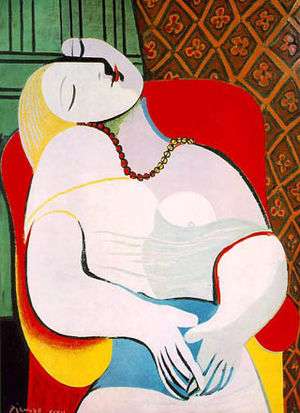Marie-Thérèse Walter
| Marie-Thérèse Walter | |
|---|---|
 Marie-Thérèse is the model for Picasso's Le Rêve ("The Dream"), 1932. | |
| Born | 13 July 1909 |
| Died | 20 October 1977 (aged 68) |
| Children |
Maya Widmaier-Picasso born 5 September 1935 |
Marie-Thérèse Walter (13 July 1909 – 20 October 1977) was the French mistress and model of Pablo Picasso from 1927 to about 1935, and the mother of his daughter, Maya Widmaier-Picasso. Their relationship began when she was seventeen years old; he was 45 and still living with his first wife, Olga Khokhlova. It ended when Picasso moved on to his next mistress, artist Dora Maar.
In Picasso's paintings, Walter appears as blonde, sunny, and bright, as in Le Rêve (1932), in contrast to his darker portrayal of Dora Maar, whom Picasso painted as the tortured "weeping woman".
Biography
Marie-Thérèse Walter was born in Le Perreux, France, Europe.
Early years with Picasso (1927-1936)
On 8 January 1927, Marie first met Picasso in front of the Galeries Lafayette in Paris. Author Herbert T. Schwartz dates their first meeting back to January 1925, at Gare Saint-Lazare, Paris; whereas author Roy MacGregor-Hastie dates the encounter up to 8 January 1928. At the time Picasso was married to Olga Khokhlova, a Russian ballerina, with whom he had a five-year-old son. He and Walter, then seventeen years old, began a relationship, which was kept secret from his wife until 1935. From 1927 onwards, Walter lived close to Picasso's family, who lived in an apartment provided by and next door to his art dealer and friend, Paul Rosenberg, in Rue La Boétie. From 1930, she stayed in a house opposite Picasso's at Rue La Boétie 44.[1]
In July 1930, Picasso bought a castle at Boisgeloup close to Gisors in the Normandie, which he used as a studio for sculptures mainly. Marie was the unseen shadow of the family and became his model and muse for both paintings and sculptures.[2]
Final years with Picasso (1935-1940)
In 1935, Marie became pregnant. When Picasso's wife, Olga, was informed by a friend that her husband had a longtime mistress who was expecting a child, she immediately left Picasso and moved to the South of France with their son Paulo. Picasso and Olga never divorced, because Picasso wanted to avoid the even division of property dictated by French law; instead, they lived separately until her death in 1955.
On 5 September 1935, Picasso and Marie's daughter, María de la Concepción, called "Maya", was born. Marie and Maya stayed with Picasso at Juan-les-Pins in the South of France from 25 March to 14 May 1936, and then at Le Tremblay-sur-Mauldre, 25 kilometres (16 mi) from Versailles, where Picasso visited on the weekends and some weekdays to play with his daughter. Maya also modeled for some of his paintings, including Maya with Doll (1938).
Marie-Thérèse became jealous when Picasso fell in love with Dora Maar, a surrealist photographer and model for Picasso, in 1935. Once, she and Maar met accidentally in Picasso's studio when he was painting Guernica. Asked about this in later life, Picasso remarked that he had been quite happy with the situation and that when they demanded that he choose between them, he told them that they would have to fight it out themselves, at which point the two women began to wrestle. Picasso described it "as one of his choicest memories."[3]
Whereas Picasso portrays Dora in his works of art as dark and in pain, as The Weeping Woman, he painted Marie-Thérèse as just the opposite: blonde and bright.[4]
Later years and death
In 1940, Marie and Maya moved to Paris, Boulevard Henri IV no 1, since the house at Le Tremblay-sur-Mauldre was occupied during World War II.
Picasso supported Marie and Maya financially, but he never married Marie.
On 20 October 1977, four years after Picasso's death, Marie-Thérèse committed suicide by hanging herself in the garage at Juan-les-Pins, South of France.[5] Maya had three children. One of her sons, Olivier Widmaier Picasso, published a biography of his famous grandfather entitled Picasso: The Real Family Story..[6] Her daughter, Diana Widmaier Picasso, is currently working on a catalogue raisonné about her grandfather's sculptures.
Incomplete list of portraits of Marie-Thérèse
- Bust of a Woman (Marie-Thérèse) (1931)[7]
- Woman with Yellow Hair (1931)
- La Lecture (1932)
- Girl before a Mirror (1932)
- The Dream (1932)
- Nude, Green Leaves and Bust (1932)
- Nude in a Black Armchair (1932)
- Seated Woman, Portrait of Marie-Thérèse Walter (1937)
- Woman in Hat and Fur Collar (1937)
- Marie-Thérèse is extensively portrayed in Picasso's Vollard Suite.[8]
References
- ↑ famsf.org, "Picasso: The Women Behind the Artist"
- ↑ The daily beast.com, Paul Laster "Picasso's Greatest Muse", The love affair of Pablo Picasso and Marie-Thérèse Walter forms a captivating new exhibit at Gagosian Gallery, curated in part by the couple’s granddaughter" 04.16.11
- ↑ Kandel, Susan (1994). ""Picasso and the Weeping Women"". Frieze. Retrieved 2011-06-29.
- ↑ Sothebys, Simon Shaw, "Reign of the Blonde Muse: An Interview with Diana Widmaier-Picasso", 17 Oct 2012
- ↑ New york times, Holland Cotter, "Picasso in Lust and Ambition", Oct. 23, 2008
- ↑ Riding, Alan (9 December 2004). "A Grandson Casts A Kind Eye On Picasso". The New York Times.
- ↑ John Richardson (2007). A Life of Picasso: The triumphant years, 1917-1932. Jonathan Cape. p. 446. ISBN 978-0-224-03121-9.
- ↑ Richard Dormant (2012-05-08). "Picasso, The Vollard Suite, British Museum, review". London: The Daily Telegraph. Retrieved 2012-05-19.
Bibliography
- Picasso, Olivier Widmaier. PICASSO: The Real Family Story. Prestel Publ. 2004. 320 p. ISBN 3-7913-3149-3 (biography)
